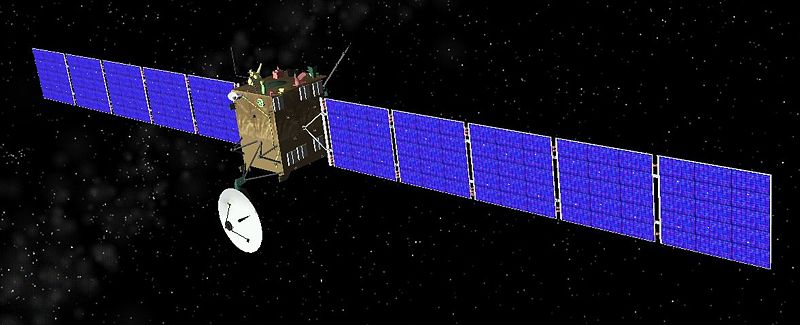Rosetta comet landing site spotted
Interview with
The team behind the comet chaser Rosetta, which is in hot pursuit of a comet  over 400 million kilometers away, are currently making plans to send a smaller probe, called Philae, to actually land on its surface. To explain how you would go about doing this, and what the surface of the comet might teach us, Kat Arney spoke to Professor Ian Wright...
over 400 million kilometers away, are currently making plans to send a smaller probe, called Philae, to actually land on its surface. To explain how you would go about doing this, and what the surface of the comet might teach us, Kat Arney spoke to Professor Ian Wright...
Ian - Earlier in the year, we did a practice of this where we took some data that we imagined we might get. And then we sat around and worked out how we would do it. the whole point of the practice was to find out what limitations of the process were and so on and so forth. Of course, you can probably imagine that the shape model we were using at that point looks nothing like the body that it turned out to be. That has been a surprise to us.
Kat - So, you didn't know what the comet actually looked like close up until you could get close enough to really photograph it.
Ian - Absolutely right. we've been using a couple of different shape models that have been produced over the years. But they're what you might call potato-shaped rather than this rubber duck shape. So, that has put some tremendously interesting constraints on the mission in terms of flight dynamics and all that jazz. But there are two aspects really to selecting the landing site. We can look at the images and we can pour over those all day long and the scientists can say, "This area looks interesting, that one looks exciting" and all that sort of stuff. But we have to factor in other aspects of this. Is the area even reachable with the orbital constraints that we've got? We have to worry about illumination. We don't want too much and we don't want too little. Too much and we get too hot and too little you don't charge the solar panels up. Of course, at any one instant, we've got to be able to communicate from the lander back to the orbiter. And obviously, we want to land on something that's reasonably doable. So, something that's reasonably flat, should we say as opposed to vertiginous. The whole thing hereon is being controlled by the mission engineers and so on and if, for whatever reasons the comet suddenly becomes violently active, we may have to take evasive action.
Kat - When are you going to release the lander or are you waiting for just the right moment?
Ian - There will be absolutely a date and time when it's scheduled to happen. It is currently pencilled in for November the 11th, but I think a decision will be made towards the end of September to either clarify that or change it. There are just huge amounts of work to do from the mission dynamics point of view.
Kat - Assuming that the lander does make it safely onto the surface of the comet, what sort of experiments is it going to be doing there? What's it looking for?
Ian - There are about 10 experiments, 10 instruments on the lander. There are cameras, there's a drilling system, there's an instrument like my own which is what is known as a gas chromatograph mass spectrometer. To explain that, it's a miniaturised analytical laboratory where we will take in samples and heat them up and then find out what the comet is made out of. There are devices which will determine the physical properties of the surface, how hard it is. There's a microphone to listen to any dust articles raining down. There are various sensors in the feet to determine temperatures, and so on and so forth. There's just a whole range of different instruments on there.
Kat - It must be an incredible feeling to be involved in this because I can remember looking up in the sky, there's been a couple of comets I think in my living memory that have been up and we've seen them. But then to think that there's actually - we've sent something up to a comet and we can now land on it. That's an incredible achievement to even get this far, isn't it?
Ian - I've been working on this for over 20 years. I can't say I've been working on it full time for 20 years, but it's never been far away over that period of time. So yes, we're excited but also, this is the end of a very long, hard, slog and we're looking forward hopefully to a successful outcome. I must admit in my lifetime, I've looked up in the sky at some fairly duff comets. Every comet of the century turns out to be not that interesting or not that exciting. So, this is a different kind of reward I think.









Comments
Add a comment